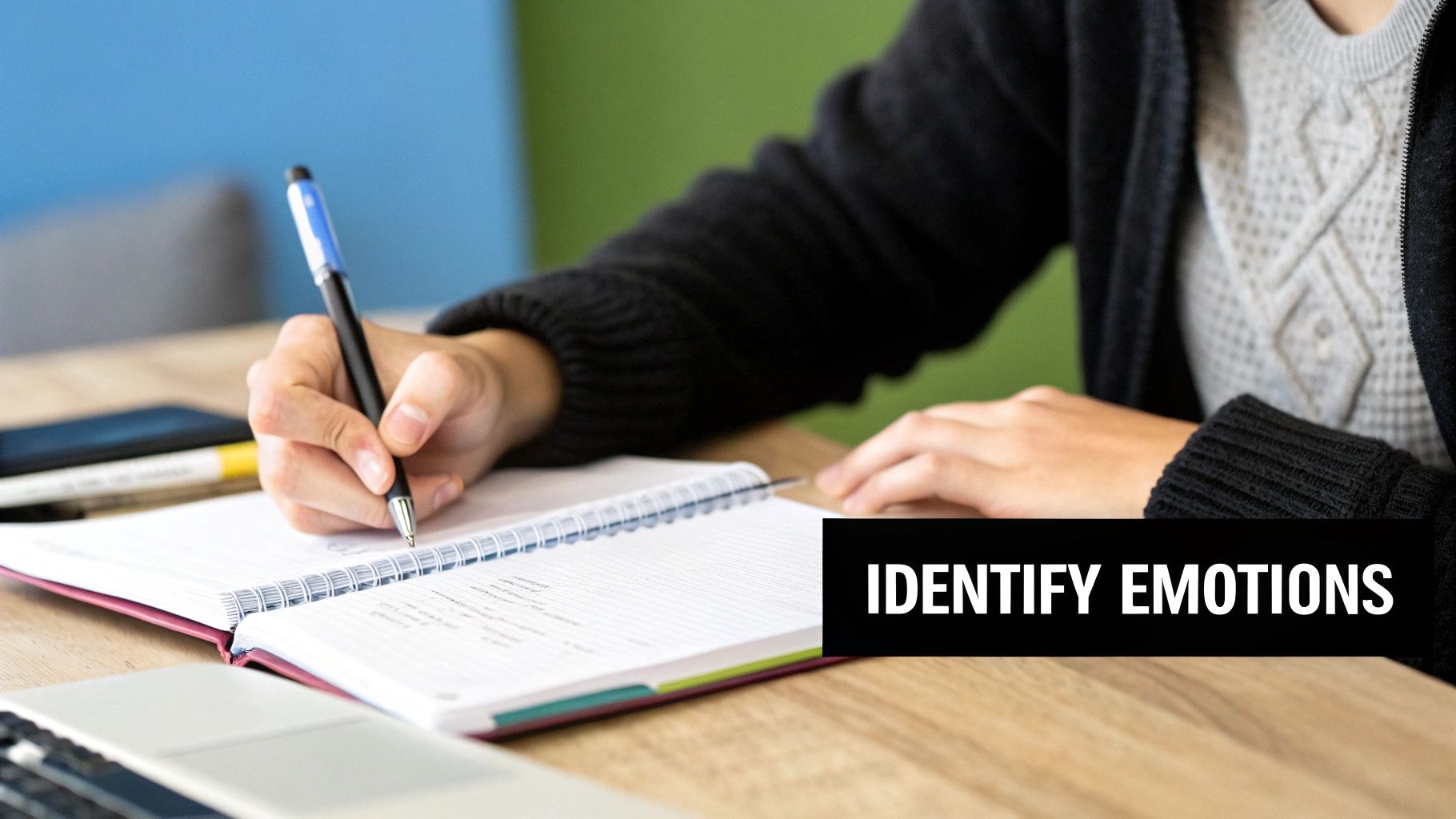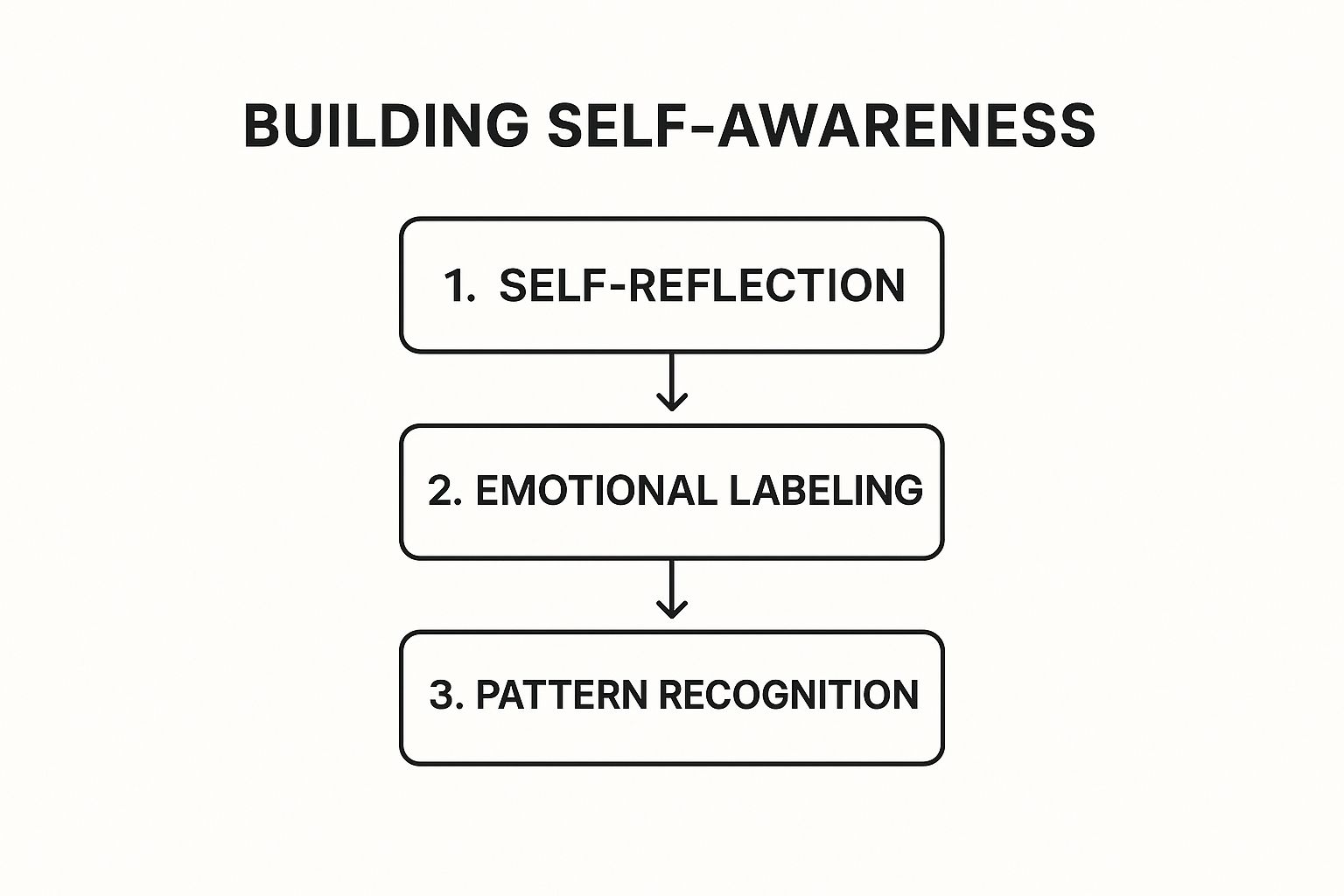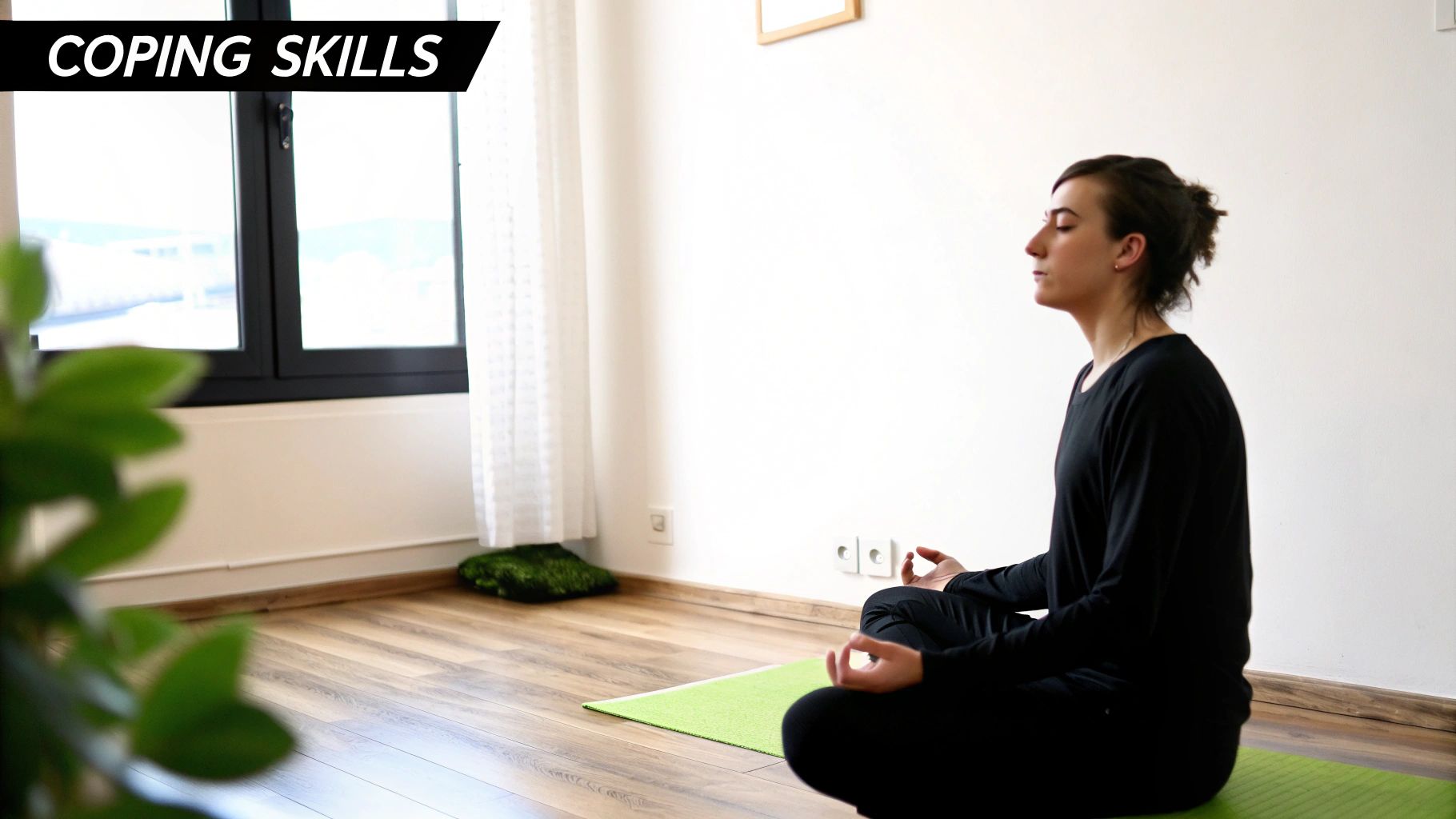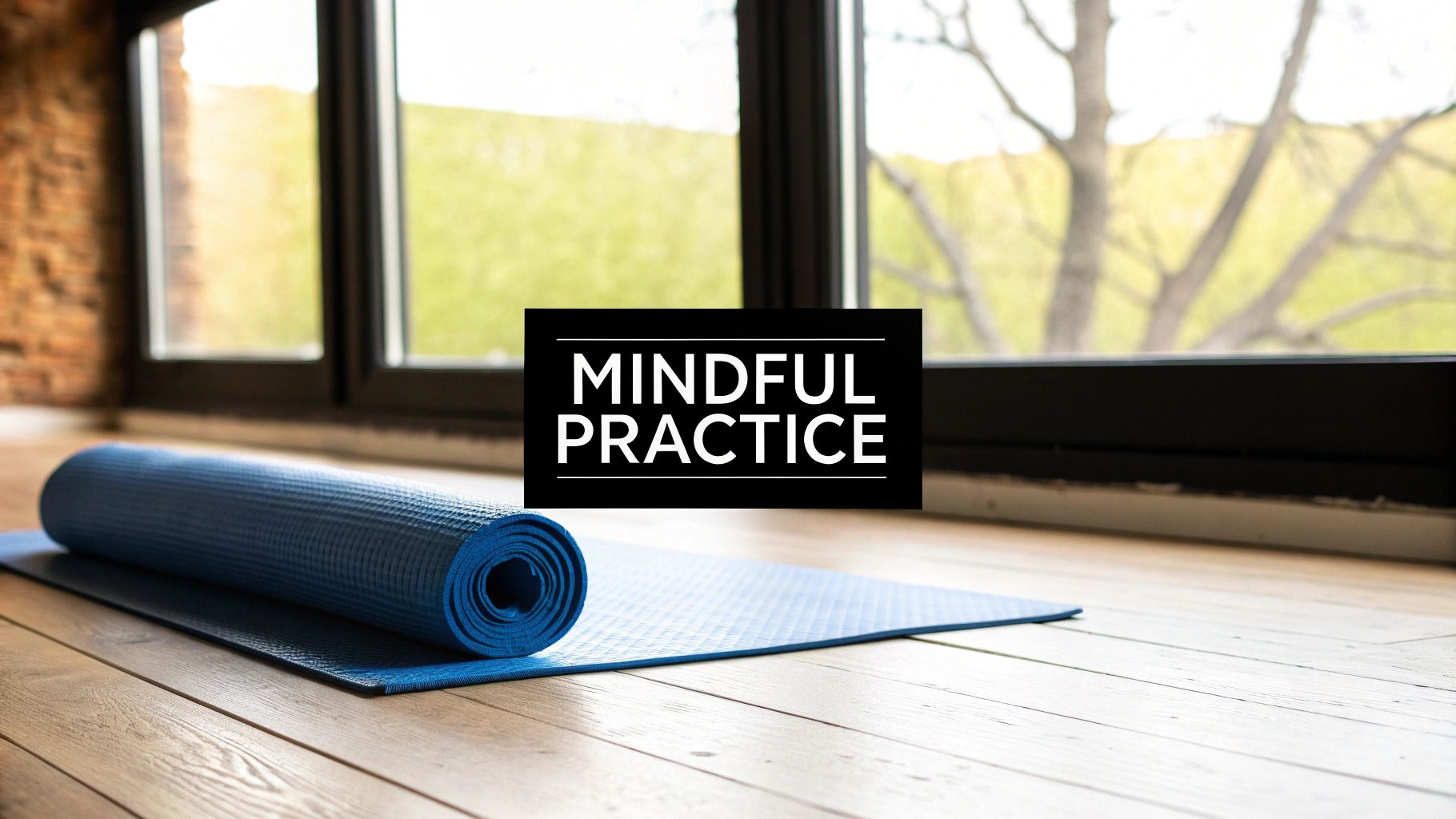
How to Build Emotional Resilience: Strategies for Strengthening Your Mindset
Share
Emotional resilience is all about having the tools in your back pocket to handle stress and bounce back when life throws you a curveball. It’s not about pretending you don't have feelings, but learning how to work through them in a healthy way and come out stronger on the other side.
Why Emotional Resilience Is a Skill You Can't Afford to Ignore
Let's be honest for a moment – modern life is a lot. Juggling deadlines, looking after family, and just trying to keep up with everything can feel like a constant battle. A lot of people think resilience is something you're either born with or you're not, but that couldn't be further from the truth. It's a skill, and just like a muscle, you can train it and make it stronger over time.
Addressing our mental health is not a luxury; it's a necessity for a functioning society. And it’s a skill we desperately need. In the UK, mental health issues are incredibly common, with around 1 in 4 adults in England facing a mental health problem each year. The stats also show that young women between 16 and 24 are particularly at risk, with 28.2% affected. If you want to dig deeper into what these numbers mean, the research from the Priory Group is a real eye-opener. These figures aren't just numbers on a page; they show exactly why building emotional resilience isn’t just a nice idea, but absolutely essential for our wellbeing.
The Ripple Effect on Work and Society
Thankfully, we're talking more openly about mental health these days, but the impact of poor emotional wellbeing is still massive. For UK businesses, the hit is huge, costing up to £56 billion a year. That cost comes from sick days, people working while unwell (presenteeism), and high staff turnover. It makes sense, then, that a team full of resilient people is going to be better at managing stress, working together, and staying productive.
Just a quick but important note before we dive in: I am not a mental health professional. The advice I'm sharing comes from a mix of solid research and my own personal experiences. If you're seriously struggling or worried, please have a chat with your GP or a qualified therapist. Think of this guide as your starting point for building a more flexible, resilient mindset.
In this guide, I’ll walk you through practical, real-world steps to help you start building this vital skill. We'll get into everything from figuring out your emotional triggers to simple relaxation tips you can use absolutely anywhere. We'll also touch on how social media plays a role and I'll recommend some fantastic mental health books and apparel that can give you a boost on your journey. Your path to becoming more resilient starts right here, by understanding why it matters so much.
Understanding Your Personal Emotional Landscape

Before you can start building stronger resilience, you first need to get to know what you're working with. Developing genuine self-awareness is the crucial first step in mapping out your unique emotional triggers and responses. It’s time to move past generic advice and get practical by creating your own 'emotional blueprint'.
This really just means learning to connect the dots between what happens around you and how you react inside. For example, you might notice that familiar feeling of dread creeping in every Sunday evening—a clear trigger for Monday morning work stress. Or maybe you feel a sudden wave of inadequacy after scrolling through a specific person's social media feed. Recognising these patterns is where building real emotional resilience begins.
Identifying Your Triggers
A trigger isn't just something that makes you angry or sad; it can be any event, person, or even a thought that sets off an intense emotional reaction. Pinpointing yours requires a little bit of detective work.
Start by paying closer attention to your body. Does your chest tighten whenever your boss sends an email after 5 PM? Do you find yourself clenching your jaw while reading the news? These physical cues are often the very first sign that you've been triggered. Once you notice the physical sensation, you can start working backwards to figure out what caused it.
"Having greater resilience doesn’t mean you don’t feel the pain... What it does mean is that you have developed tools and an internal capacity from which to draw strength and resolve when loss occurs."
Understanding your personal triggers isn't about avoiding them entirely—that’s often impossible. Instead, it’s about knowing they exist so you can prepare for them and learn to manage your response in a healthier way. For a deeper look at how our past experiences can shape these reactions, our guide on what is trauma-informed care offers some valuable insights.
Simple Tools for Self-Discovery
You don't need any complicated methods to start mapping your emotional landscape. Two of the most effective tools I've come across are simple journaling and basic mindfulness.
- Journaling Prompts: At the end of each day, take a few minutes to ask yourself: "When did I feel most stressed or upset today?" and "What was happening right at that moment?" Try to be as specific as you can. Just writing it down helps you start seeing patterns you might have missed before.
- Mindful Check-ins: Set a reminder on your phone a few times a day to just pause and ask, "What am I feeling right now?" Don't judge the feeling or try to change it; just name it. This simple practice builds your emotional vocabulary and your overall awareness.
These techniques help you shift from being a passenger in your emotional life to sitting in the driver's seat. They give you the clarity you need to apply more targeted strategies, turning self-awareness into a powerful tool for building lasting emotional resilience.
Practical Strategies for Everyday Resilience
Knowing what sets you off emotionally is one thing, but turning that awareness into action is how you really start to build emotional resilience. This is where we get practical, looking at everyday techniques you can weave into your life without needing a complete overhaul. Honestly, small, consistent shifts are so much more powerful than grand gestures that you can't stick with.
The goal here is to give yourself a few simple tools that feel manageable, even on the days when everything feels like a struggle. By focusing on how you think, how you breathe, and how you live, you create a sturdy foundation for your emotional wellbeing.

This process shows that real, practical resilience starts from the inside out. It begins with taking a moment to reflect on our feelings and then learning to spot and understand those recurring emotional patterns.
Reframe Your Unhelpful Thoughts
The way we talk to ourselves matters. A lot. Cognitive reframing is a brilliant technique for challenging and changing those negative or unhelpful thoughts into something more balanced and constructive. It’s not about pretending the negative doesn't exist, but about finding a more useful way to look at it.
For instance, after making a mistake at work, it’s easy to fall into the trap of thinking, "I've completely failed, and everyone thinks I'm incompetent." That kind of thinking just sends you spiralling into anxiety and self-doubt.
A reframed version could sound more like: "Okay, that didn't go as planned, but what’s one key lesson I can take from this for next time?" This simple shift doesn’t deny the mistake; it turns it into a chance for growth, which is at the very heart of emotional resilience.
Master Simple Mindfulness Exercises
Mindfulness is really just about bringing your attention to the present moment without judging it. When you feel overwhelmed, your mind is usually racing—either dwelling on the past or worrying about the future. Simple breathing exercises are fantastic for anchoring you in the now, and they can bring an instant sense of calm.
One of the most effective methods I've found is the 4-7-8 breathing technique:
- Breathe in quietly through your nose for a count of four.
- Hold your breath for a count of seven.
- Exhale completely through your mouth, making a whoosh sound, for a count of eight.
Just repeating this cycle three or four times can act like a natural tranquilliser for your nervous system. If you're dealing with long-term stress, looking into specific strategies to rebuild resilience after burnout and chronic stress is a really important step for your emotional health.
For those moments you need a quick reset, here are a few exercises that are easy to do no matter where you are.
Simple Relaxation Tips You Can Do Anywhere
| Technique | How It Works | When to Use It |
|---|---|---|
| Box Breathing | Inhale for 4, hold for 4, exhale for 4, hold for 4. This simple, rhythmic pattern helps regulate your breathing and calm your nervous system. | When you feel your thoughts racing before a meeting or during a stressful commute. |
| 5-4-3-2-1 Grounding | Name 5 things you can see, 4 you can touch, 3 you can hear, 2 you can smell, and 1 you can taste. It pulls you out of your head and into the present. | Perfect for moments of high anxiety or when you feel a panic attack coming on. |
| Progressive Muscle Relaxation | Tense a specific muscle group (like your hands) for 5 seconds, then release for 10. Work your way through your body. | Great for releasing physical tension at your desk or before trying to sleep. |
These techniques are brilliant because they're discreet and you don't need any special equipment—just a minute or two to yourself.
Prioritise Your Lifestyle Foundations
You can't expect to build a strong house on a weak foundation, and the same goes for your mind. Your daily lifestyle choices play a huge, non-negotiable role in your ability to handle stress and bounce back from challenges.
- Sleep: Try to get 7-9 hours of good-quality sleep a night. A bad night's sleep can make even the smallest stressor feel like a catastrophe.
- Nutrition: A balanced diet literally fuels your brain. Highly processed foods and too much sugar can lead to mood swings and energy crashes, making it harder to cope.
- Movement: Regular physical activity is one of the most powerful stress relievers out there. Even a brisk 15-minute walk can clear your head and give your mood a much-needed boost.
These aren't just 'nice-to-haves'—they are the essential pillars that support your mental and emotional health. For more detailed advice, learning how to manage stress can give you even more valuable tools for your toolkit.
Building Your Resilience Through Connection

We often think of building emotional resilience as an inside job, something we have to figure out on our own. While the strategies we've talked about so far focus on your internal world, our connections with others create a powerful external support system. This is absolutely essential for bouncing back when life gets tough.
This goes way beyond the generic advice to just 'talk to someone'. It’s about consciously and actively cultivating a network of people who genuinely support and energise you. The right connections act as a buffer against stress, offering fresh perspectives and reminding us we’re not alone in our struggles.
Curating a Supportive Network
Let's be honest, not all relationships are created equal, especially when it comes to our mental wellbeing. Take a moment to think about the people in your life. Who leaves you feeling uplifted? And who, if you're really honest, leaves you feeling drained?
A truly supportive network isn't about numbers; it's about the roles people play. You might have:
- The Listener: That one friend who just lets you vent without jumping in with judgement or trying to 'fix' it.
- The Motivator: The person who helps you see the opportunity hidden inside a setback.
- The Practical Helper: The one who shows up with a meal or helps with a task when you're completely overwhelmed.
Recognising these different roles helps you know exactly who to turn to for specific needs. It’s about quality over quantity. Even one or two of these deeply supportive relationships can make a huge difference in your resilience.
A crucial part of this is learning to communicate what you actually need. People aren't mind readers. Simply saying, "I'm not looking for advice right now, I just need to vent" can guide them to support you in the way that's most helpful.
The Double-Edged Sword of Social Media
Social media can be a fantastic tool for finding your community, but it can just as easily become a source of comparison and anxiety. A curated feed often presents a distorted reality, leaving us feeling inadequate. The key is to use it with intention. Unfollow accounts that make you feel rubbish. Seek out groups or creators who foster genuine connection and real support.
This is especially relevant for younger people. Recent UK data has flagged a massive generational divide in stress levels. An alarming 91% of all UK adults have experienced high or extreme stress in the last year. Young adults aged 18-24 are the most affected, with nearly 3 in 10 taking time off work for their mental health – a rate three times higher than those over 55. You can learn more about how these stress levels impact different age groups here.
By being mindful of our online habits and focusing on real-world connections, we can protect our mental space. Fostering these relational skills is a core part of what we call social emotional learning, a vital skill for both adults and children. Reaching out isn’t a sign of weakness; it’s an act of strength that reinforces the simple truth that we are always stronger together.
How to Nurture Resilience in Children and Young People
Teaching children to be emotionally resilient is one of the most powerful things we can do for them. It’s not about shielding them from life’s knocks, but giving them the tools to handle them. We’re talking about the inner strength to navigate everything from a fallout with a friend to the very real pressures of exams and social media. This foundation isn't built in big, dramatic lessons; it’s forged in the quiet, everyday moments we share.
The most effective way we teach this is by showing, not just telling. Kids are always watching us, learning how to react to stress by seeing how we cope. When you hit a snag, try to model a healthy response. For example, instead of getting flustered when a piece of flat-pack furniture isn’t cooperating, you could say out loud, “Right, that didn’t go to plan. Let’s have a cup of tea and think of another way to tackle this.” This simple shift in language shows them that problems are puzzles to be solved, not reasons to panic.
Creating a home where they feel safe to express big, messy feelings is just as important. They need to know that every emotion is valid – sadness, anger, fear, the lot. When they’re upset, take a breath and validate what they’re feeling before you try to fix it. Saying something like, “I can see you’re feeling really furious about that,” lets them know you get it. This builds their emotional vocabulary and, crucially, their trust in you.
Practical Ways to Build Their Resilience
We can’t ignore the state of children's mental health. The numbers are worrying: one in six children aged 7 to 16 in the UK are now thought to have a mental health problem. Building resilience is one of our best preventative strategies.
Here are a few practical examples that really work:
- Practise Problem-Solving Together: Don’t just solve their problems for them. If they’re feeling overwhelmed by a big school project, sit with them and help break it down into tiny, manageable chunks. This teaches them how to face challenges instead of just avoiding them.
- Encourage Healthy Risks: Let them take age-appropriate risks. This could be anything from climbing a little higher on the play structure to ordering their own food in a café. Each time they overcome a small challenge, they’re banking a little bit more self-belief and proving to themselves that they’re capable.
- Hold Firm on Boundaries: It might sound counterintuitive, but clear routines and consistent boundaries actually make children feel safe. That sense of security is the foundation from which they feel brave enough to explore the world and learn to cope when things don’t go to plan.
Supporting Them in a Modern World
Today's kids are growing up with a unique set of pressures, especially from the online world which can be a minefield of comparison and bullying. The key is to keep the conversation flowing about their digital lives. Ask them what they’re enjoying and what’s making them feel rubbish online, and make sure they know you won’t judge their answers.
A strong foundation starts right from the beginning. Even the way children play can build crucial skills for later life. Exploring a guide to developmental toys for toddlers can give parents some great ideas for making playtime a powerful learning experience.
It's also fascinating to see how our ability to cope can be shaped by where we live. The UK Emotional Resilience Index, which pulls data from sources like the ONS and NHS, shows that different regions have varying capacities for dealing with stress. This really brings home how important local support networks are. You can find out more about these regional differences on toughminds.org.
Please remember, I am not a mental health professional. If you have serious concerns about a child's wellbeing, it is essential to speak with a GP or a qualified professional for guidance and support.
Building Your Resilience Toolkit: Resources & What's Next

Learning to build emotional resilience isn't a one-and-done deal; it's an ongoing practice. Think of this final section as your starter toolkit to carry on the journey, packed with go-to resources to support you.
The conversation around mental health is getting louder, which is fantastic, but finding genuinely helpful resources can still feel like searching for a needle in a haystack. Prioritising our wellbeing is crucial, especially when you learn that mental ill-health costs UK businesses up to £56 billion every year in lost output and staff turnover.
So, let's dive into some practical next steps and tangible tools to keep in your back pocket.
Influential Mental Health Books
Sometimes, the best way to gain a new perspective is to get lost in a good book. Reading about others' experiences and expert insights can be incredibly validating, reminding us that we're never truly alone in our struggles. For a great starting point, check out this list of the best mental health books.
Here are a few titles that I’ve found particularly powerful:
- "Reasons to Stay Alive" by Matt Haig: A raw, brutally honest, and ultimately hopeful account of living with depression. It’s a book that offers profound understanding for anyone who has struggled.
- "The Body Keeps the Score" by Bessel van der Kolk: A groundbreaking look at how trauma physically reshapes the body and brain, offering clear paths toward healing.
- "Man's Search for Meaning" by Viktor Frankl: A truly profound exploration of finding purpose and meaning even in the most unimaginable circumstances. It's a classic for a reason.
Mental Health Apparel That Starts a Conversation
What we choose to wear can be a quiet form of self-expression and a powerful statement of support. A few brilliant UK brands are now creating thoughtful mental health apparel designed to challenge stigma one hoodie at a time.
Pulling on a jumper with a simple, encouraging message can be a personal reminder to be kinder to yourself on a tough day. More than that, it can spark important conversations with friends, family, or even strangers, creating a ripple effect of awareness and support.
A Quick But Important Note: Please remember, I am not a mental health professional. The advice and resources shared here are for informational purposes only. If you're worried about your own mental health or that of a child, it's so important to reach out to a GP or another qualified professional for support.
UK Helplines for Immediate Support
When you need to talk to someone right away, these services are there for you.
- Mind: An incredible charity offering advice and support to empower anyone experiencing a mental health problem.
- The Samaritans: A completely free and confidential service providing a safe space to talk, 24/7. You can call them about whatever’s getting to you on 116 123.
Of course, as you start exploring how to build emotional resilience, it’s completely normal for a few questions to bubble up. Having some clear, straightforward answers can make a world of difference, helping you start this journey with a bit more confidence.
Can You Actually Learn To Be More Resilient?
Absolutely. One of the biggest myths out there is that resilience is some fixed trait you’re either born with or you’re not. The truth is, it’s much more like a muscle.
It’s a dynamic set of skills that you can intentionally develop and strengthen over time. It just takes a bit of consistent practice and self-awareness.
How Long Does It Take To See A Difference?
Building up your emotional resilience is a gradual process, not an overnight fix. You might start noticing small shifts within a few weeks, like feeling a little less reactive when a minor stressor pops up.
But creating deep, lasting change is more of a long-term commitment. The key is to be patient and kind to yourself along the way.
True resilience isn’t about never feeling overwhelmed; it's about developing the tools and inner strength to draw from when challenges inevitably arise. It's knowing you can get through it, even when it's hard.
What's The Single Most Important First Step?
If you're wondering where on earth to begin, the most powerful first step is often the simplest one: focus on your breath.
Committing to just a five-minute breathing exercise each day is a small but mighty starting point. This simple act helps calm your nervous system, grounds you in the present moment, and creates a solid foundation you can build all your other resilience strategies on top of.
At Little Fish Books, we believe in nurturing emotional literacy right from the very beginning. You can explore our collection of books, activities, and resources designed to support the emotional growth of children and young people over at https://thatsokay.co.uk.
